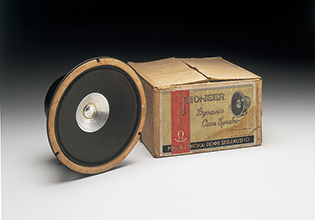STORY
01
TAD HISTORY
Prior to the Advent of TAD(1937-1978)
Pioneer, from which TAD descended, was founded as a speaker manufacturer by Nozomu Matsumoto in 1937, when he developed the A-8, the industry’s first hi-fi dynamic speaker in Japan.
In 1975, a project was launched at Pioneer to develop high-end speakers targeted at the professional sound market around the world. The project was named the TAD Project.
A-8 dynamic speaker, the first product introduced by Pioneer.
TAD Earns the Worldwide Recognition as a Leading
Brand of Professional Speakers (1978-2000)
Pioneer invited Bart Locanthi, then a renowned professional audio engineer in the United States, to join the TAD Project. He accepted the offer and graciously shared his wealth of expertise in and unrivaled passion for speaker design and engineering with his counterparts at Pioneer, enlightening them on how to conduct laboratory simulations and testing as well as how to incorporate an unprecedented level of precision and authentic technologies into speaker design.
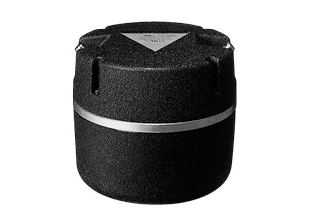
The first speaker unit that came out of the TAD Project was the TD-4001 compression driver, which was unveiled at the Acoustic Engineering Society (AES) convention held in the United States in 1978. When the TD-4001, which offered unheard-of performance characteristics, became commercially available in the United States, it created a sensation in the pro audio industry and eventually found its way into famed recording studios around the world, including those designed by Tom Hidley, who was a top-rated acoustic designer of the time, as well as AIR Studios, Capitol Records studios, and Record Plant.
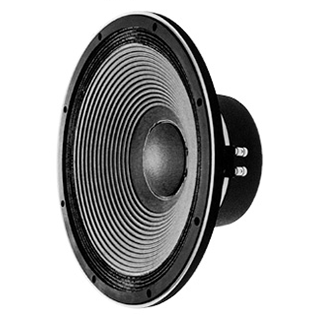
TAD speaker units were also used as part of a sound reinforcement system during the concert tour the Eagles made around Japan in 1979, and the performance of the TAD speakers dazzled the audiences. Impressed with the reputation of TAD speakers, big-name musicians such as Jimmy Page and Prince installed TAD speakers in their private recording studios.
The 1980s and 1990s saw the TD-4001 and other TAD compression drivers and woofers installed in more than 300 leading recording studios in 20 countries. By the turn of the century, TAD speakers and the design philosophy behind them had won the trust of professional sound engineers.
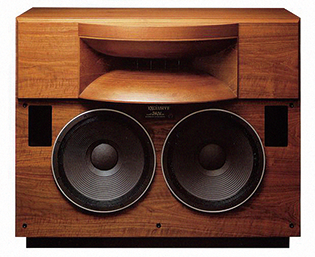
TAD Makes Inroads into the Consumer Market
(2000 to present)

The TAD-M1, the first TAD-branded speaker system for consumer use, was unveiled at the Consumer Electronics Show (CES) in the United States in 2002. The TAD-M1 was intended to reproduce sound in a natural and realistic manner and deliver high-dimensional sound imaging and sound-field immersion. Engineering attention was focused on achieving smooth dispersion and high definition of sound, which combine to deliver the rich, nuanced timbre and resonance of music as well as its spaciousness and lingering effects to the listener.
The first engineering focus was to achieve natural sound dispersion. Just as a drop of water makes perfect ripples across the water surface, the sound dispersion is about a flow of sound from the speaker dispersing continuously and naturally to fill the space. To achieve natural sound dispersion, the sound directivity from each unit in a speaker system must be accurately controlled across the entire frequency range.
This was made possible by the CST (Coherent Source Transducer) Driver we developed. The coaxial CST Driver with a tweeter dome and a midrange cone enables the smooth, ultra-wide-range reproduction of sound from 250 Hz to 100 kHz and works like a single-source full-range speaker to offer uniform directional characteristics, both horizontally and vertically.

The second engineering focus was to achieve the high-definition reproduction of sound. For a speaker system to achieve natural-sounding reproduction, it must be able to reproduce sound from audio sources of the latest formats that cover frequency ranges well beyond the audible band of up to 20 kHz. Sound in a natural environment contains a harmonic overtone of an ultra-high frequency, which is known to enhance the fundamental tone in the audible band.
A speaker diaphragm made of beryllium, which is the lightest and most rigid of metals and yet has high internal loss, is ideal for reproducing ultra-high frequency sound. The CST Driver has a tweeter done and midrange cone made of beryllium. Combined with an optimally shaped diaphragm and a finely-designed voice coil, the beryllium done tweeter provides a response as high as 100 kHz. The shallow-shaped, large-diameter midrange, made possible by the use of beryllium, offers bass reproduction down to as low as 250 Hz.
The CST Driver built into the TAD-M1 boasts the unified acoustic center of the tweeter and midrange, ultra-wide- range reproduction of up to 100 kHz, and well-controlled directivity performance, and is the epitome of years of technical achievements and expertise we have accumulated in speaker design. The coaxial design of the tweeter and midrange was made possible by the high-precision processing method that we have mastered, and the beryllium diaphragm, the only commercially available beryllium diaphragm in the world, was produced using our proprietary vapor deposition technique.
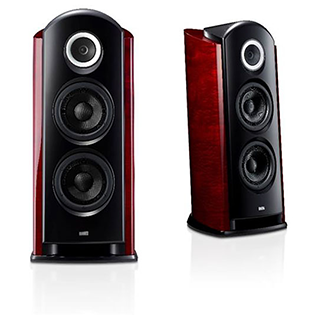
The CST Driver has been incorporated also into the TAD Reference One speaker system released in 2007 and other TAD speakers introduced to date.
Next Story: 02. TAD Audio Components, the Best Companions to TAD Speakers
